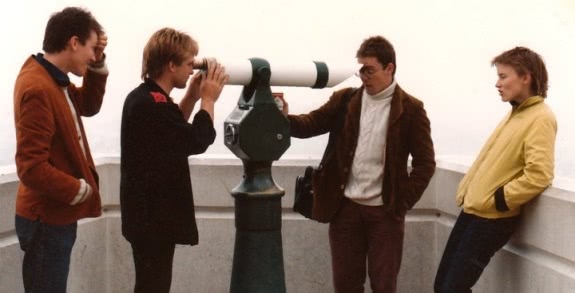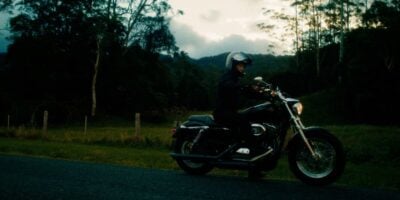Paul Kean’s life was changed by stolen songs.
Music was ever-present as he grew up in New Zealand in the ’60s – as dependable as the slow, cold mist of Christchurch rain – largely thanks to his parents. His father had a soft spot for the piano and a deep baritone voice; his mother a passionate, undying love of hymnals.
But it wasn’t until he travelled overseas that the nature of his obsession shifted, and the slow solidification that turns an interest into a passion began to grip him.
“In 1966 I went to UK with my family and on the way over I bought a small transistor in Aden for a pound,” he explains now. “When we got to London I’d listen to pirate radio stations all the time and went to sleep with it under my pillow tuned to Radio Caroline or Radio Luxembourg. Troggs, Kinks, Hollies, Roy Orbison, Beatles, Stones, Easybeats, Loving Spoonful, Mamas and Papas, the Walker Brothers… I think 1966 was a big influence on my musical upbringing.”
And yet music still didn’t seem like a viable career to Kean. It didn’t to many back then. That was the time, and that was the place: Christchurch was growing but not yet grown, and there were ways it still felt like its own distant planet. The road tunnel connecting the city with its seaport, Lyttelton, was only built in 1964, and the agricultural industry remained its dry, dusty, beating heart. Becoming a musician wasn’t unheard of or insane – it was merely unusual.
But the world is defined by the unusual, and as Kean’s obsession with music began to grow, so too did the interest of many others across the city – others like Kaye Woodward, Kean’s eventual bandmate. “I’ve never been a very focused or ambitious person so actually I had no idea what I wanted to do,” Woodward says. “I went to university by default and it was during those years that I became interested in music.”
What struck Woodward most was the accessibility of songwriting; how little was required to be in a band. Punk acts like the Sex Pistols and The Clash had proved that barely anything was needed in the way of training or tradition to become successful, and when the democratisation of music came, it came fast.
Indeed, it was at a Clash concert that Woodward connected with Robert Scott, another budding creative. Scott was looking for a place to crash, and Woodward, eager to connect with others who felt the way she felt about the world, was happy to provide one. “He moved into my flat and we started playing guitars together – even though I could barely play,” Woodward says.
It was all so sudden and so new. Woodward had little in the way of technical training, but her eyes were wide open, and she was eager to learn. “It was all quite wondrous to me,” she says. “I loved the songs [Scott] came up with to play together and how they sounded.”
At that stage, they were merely laying the groundwork for the music they would later make, but it was enough. Enough, certainly, to satiate the creative impulses they still couldn’t necessarily quantify or even really explain. After a time they moved, together, and found themselves in the company of two more musically minded roomates: Paul Kean, he of the pirate radio, and Malcolm Grant, an unassuming creative with an ear for picking pop hits and a self-confessed reluctance to follow anything resembling a crowd. “I’m not… the kind of person who ‘wants to do things with my life’”, he explains.
First impressions were made. Scott though they all seemed “great”. Woodward thought Kean looked like the doer of the pair, thanks largely to his habit of wearing overalls. At the same time, she thought Grant often seemed easily irritated, annoyed by having to do something as minor as greeting house guests. “He gave the impression it was a pain in the arse to open the door,” she says. For his part, Grant thought they didn’t know how to cook toast.
And yet, the difference in culinary habits aside, the four quickly became close, and before long, the bond between the group was palpable. There is a reason, after all, they have been playing together ever since – a reason they have managed to stay together through almost 40 years of touring. In a few short months they would become the band known as The Bats – but before that, they became friends.
–
Much has been written these days about the Dunedin Sound, and the legacy of labels like Flying Nun, the veritable institution that would eventually release the majority of The Bats’ musical output. The whole scene has been canonised, endlessly disseminated into textbooks and into legends.
But at the time it didn’t seem so complicated – or so weighty. It was just a good time to be making music. That’s all. “Back then we could be on the unemployment benefit without being expected to look for a job,” says Woodward. “This meant we could play all day and travel without having to get time off work or have the pressure to make enough money to support us all.”
As a result, The Bats worked hard and fast. Their first three EPs fell into line quickly – By Night dropped in ’84, And Here Is ‘Music For The Fireside’ the year later, and Made Up In Blue the year after that. Woodward and Scott were neatly dividing up vocal lines, sharing the mic, though Scott was initially wary of the responsibilities of vocalist. “It took a few goes,” he says. “I was very rough at playing the guitar and singing.”
It helped that there was a surplus of bands around to inspire them. There existed a healthy sense of competition, Scott says, and there was the sense that everyone was nicking a little bit of something from everyone else – even if it was merely a question of borrowing a little confidence.
“There was always someone playing and we got to enjoy many special nights in Dunedin and Christchurch,” Scott says. “It was mostly pretty friendly between people. We’d share gear and transport with [other bands]. All the songwriters were coming up with great songs and a lot of them have stood the test of time well.”
The kind of music The Bats were making as a band was beginning to become clear as well. Kean, the bass player, began to develop a fluid, rubbery style of playing, over which drummer Grant would pound out fast, simple rhythms, similar to those favoured by his hero Maureen Tucker of The Velvet Underground. It was a pretty kind of punk, a very melodious kind of madness, and The Bats proved ever-willing to embrace the more poppy sensibilities of their sound.
Helpfully, they proved good communicators too. While some bands can be overly wrapped up in ego, or so concerned with the finished song that they become lost in the process, The Bats worked hard to maintain open channels of conversation. “We discuss all aspects of the song quite a bit,” says Scott. “Sometimes we just jump in and bash it out, other times we labour over it quite a lot.”
For his part, Grant, ever world-weary and willing to simplify, puts it a different way. “We step on each other’s toes all the time,” he says. “It’s called creativity.”
It helped they had a goal, albeit a hazy one. Though all the while the band members were working towards recording a debut album, they just didn’t really know what it was going to sound like. A catalogue was being assembled slowly, and as they played increasingly regular gigs, a vague tracklisting began to take shape. But it was still a kind of mystery, a collection of forces waiting for one brief, all-important spark.
–
It came in the form of a casual offer. The Bats were travelling throughout the UK, trying to make a name for themselves internationally, when the possibility of some studio time in Glasgow arose. They leapt at the chance. The album that would eventually be known as Daddy’s Highway – the record that would establish them as a powerhouse at home and abroad – was recorded on what amounted to a whim.
“No idea how long it took,” Grant says of the recording time in Scotland.
Woodward’s memory serves her a little better – she guesses it was about a week. They had limited gear, she says, and still no real sense of what the finished product was going to sound like. “The kick pedal was set up against a door because we didn’t have a bass drum,” she explains.
Kean took on the mantle of producer, though his position was far from an autocratic one, and he took a great deal of direction from his bandmates. “We just wanted it to sound reasonably live and real without any mucking around with overproduction. Good strong instrument sounds, vocal harmonies and a live performance.”
It was a predictably piecemeal process. Though a good chunk of the songs were laid down to tape in Scotland, before long the band returned home, and finished the thing off in Christchurch. “I was still coming to grips with getting my ideas across in the studio,” Scott says. “I still do.”
That mix of hesitancy, headstrong confidence, and lo-fi audio flourishes defines The Bats, and Daddy’s Highway in particular. The album is as unfocused as the studios in which it was recorded – songs, tones and instrumental styles freckle and fray like daubs on the floor of a painter’s studio. But it works, somehow. It works and then some. It is one of the purest expressions of self the band has ever released, the sound of four friends hewing up the things they love into one guache, glorious package. And it was made as though it were the easiest thing to do in the world.
–
The Bats have released seven albums in the time since Daddy’s Highway, but it is still that first record that so many are drawn to. Understandably, the band members have mixed opinions on it. Nobody ever really loves their best-known work, or if they do, that love is tainted by a strange mix of self-awareness and humility.
“I loved it at the time,” Woodward says. “But then I went off it a bit thinking the recording wasn’t great as we went into the ’90s and used some enormous desks. But now I love it again as I appreciate its range and character and how well the songs are expressed.”
Kean agrees. He attributes the record’s extraordinary half-life to its evergreen appeal to the youth; to the way it makes sense of the matters of the heart, and lays bare the strange forms of self-hatred that begin to accumulate as you’re forced to make sense of the world.
“I’ve always thought people who were going through their teens, falling in love for the first time and stepping out onto their own chosen paths embrace the music of their time through their exciting transition years,” Kean says. “They tend to hold onto that music for their life.”
It’s true. But it’s also true that there is something about the album that remains harder to describe. Its high points are not so easy to quantify, and within it there exists the right balance of the uncanny and the uplifting. Grant, as ever, puts it in the least amount of words, but the words that make the most sense. Why do so many people come back to the record? “Not sure,” he says. “But I’m happy they do.”
The Bats will perform as part of Sydney Festival on Sunday January 29 at the Magic Mirrors Spiegeltent, Hyde Park. For more information, head here.

































